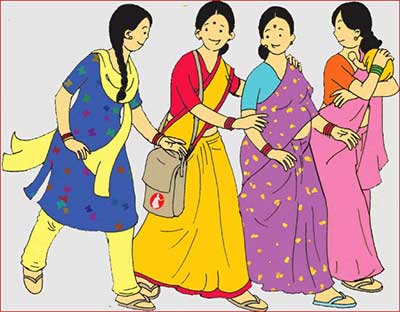Date: 03/11/2022
Relevance: GS-1: Role of women and women’s organization, population and associated issues, poverty and developmental issues.
Key Phrases: ASHA workers, National Rural Health Mission, marginalised communities, primary health centres, Channels of communication, volunteers, chloroquine for malaria.
Context:
- With the Covid-19 pandemic on halt the plight of ASHA workers is in focus,they were the real warrior during these tough times.
Who are ASHA workers?
- ASHA workers are volunteers from within the community who are trained to provide information and aid people in accessing benefits of various healthcare schemes of the government.
- They act as a bridge connecting marginalised communities with facilities such as primary health centres, sub-centres and district hospitals.
- The role of these community health volunteers was first established in 2005 under the National Rural Health Mission (NRHM).
- ASHAs are primarily married, widowed, or divorced women between the ages of 25 and 45 years from within the community.
- They must have good communication and leadership skills; should be literate with formal education up to Class 8, as per the programme guidelines.
- They are selected by and accountable to the gram panchayat (local government)
Do You Know?
- The aim of Government is to have one ASHA for every 1,000 persons or per habitation in hilly, tribal or other sparsely populated areas.
- There is around 10.4 lakh ASHA workers across the country, with the largest workforces in states with high populations – Uttar Pradesh (1.63 lakh), Bihar (89,437), and Madhya Pradesh (77,531).
- Goa is the only state with no such workers, as per the latest National Health Mission data available from September 2019.
What do ASHA workers do?
- Awareness Creation:
- They go door-to-door in their designated areas creating awareness about basic nutrition, hygiene practices, and the health services available.
- They focus primarily on ensuring that women undergo ante-natal check-ups, maintain nutrition during pregnancy, deliver at a healthcare facility, and provide post-birth training on breastfeeding and complementary nutrition of children.
- Screening of Infections and timely Medications:
- They are also tasked with screening for infections like malaria during the season.
- They also provide basic medicines and therapies to people under their jurisdiction such as oral rehydration solution, chloroquine for malaria, iron folic acid tablets to prevent anemia, and contraceptive pills.
- Now, they also get people tested and get their reports for non-communicable diseases.
- Other than mother and child care, ASHA workers also provide medicines daily to TB patients under directly observed treatment of the national programme.
- Counselling of Women and Children:
- They counsel women about contraceptives and sexually transmitted infections.
- ASHA workers are also tasked with ensuring and motivating children to get immunised.

Role of ASHA network in pandemic response:
- ASHA workers were a key part of the government’s pandemic response, with most states using the network for screening people in containment zones, getting them tested, and taking them to quarantine centres or helping with home quarantine.
- During the first year of the pandemic, when everyone was scared of the infection, they had to go door-to-door and check people for Covid-19 symptoms.
- They also faced a lot of harassment because there was so much stigma about the infection that people did not want to let them in.
Key Challenges they face:
- One of the biggest issues facing rural health services is lack of information.
- Another area of concern is the lack of resources.
- Medical facilities are understaffed and lack adequate equipment for various basic procedures like deliveries. Simple tests, like for sickle cell anaemia and HIV, cannot be conducted.
- Hostile Attitudes: ASHAs report hostile attitudes of the communities they serve due to the breakdown of social relations, trauma due to displacement, and loss of family members, particularly their husbands.
- Demotivating Service Conditions: Lack of further career prospects and adequate service conditions of frontline workers in Anganwadi Centres such as Anganwadi workers (AWWs), ASHAs and ANMs.
- No Permanent Job: The workers do not have permanent jobs with comprehensive retirement benefits like other government staff.
Way Forward:
- The goal for the next 25 years should be to funnel resources and attention into rural India.
- Channels of communication between the government and the rural
population need to be robust.
- A deadly pandemic makes the value of these channels obvious — but in order to get people on board, information needs to be sent out much more effectively and in a hands-on manner.
- Role of ASHA workers needs to be formalised. Recognising them as workers allows them dignity and protection, and helps them to be taken seriously — by the state, the gram panchayat responsible for the disbursal of their funds.
Sources: Indian Express
Mains Question:
Q. Discuss the role of ASHA workers in rural society. What are the key challenges faced by them? (250 Words).








